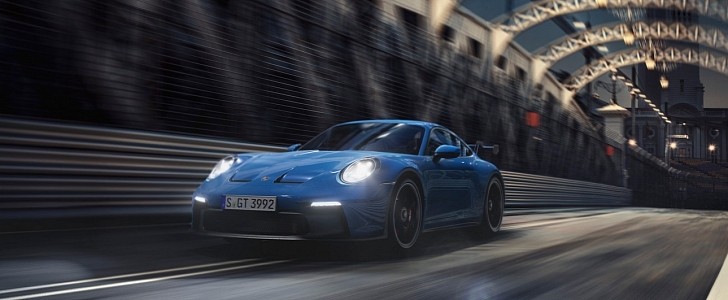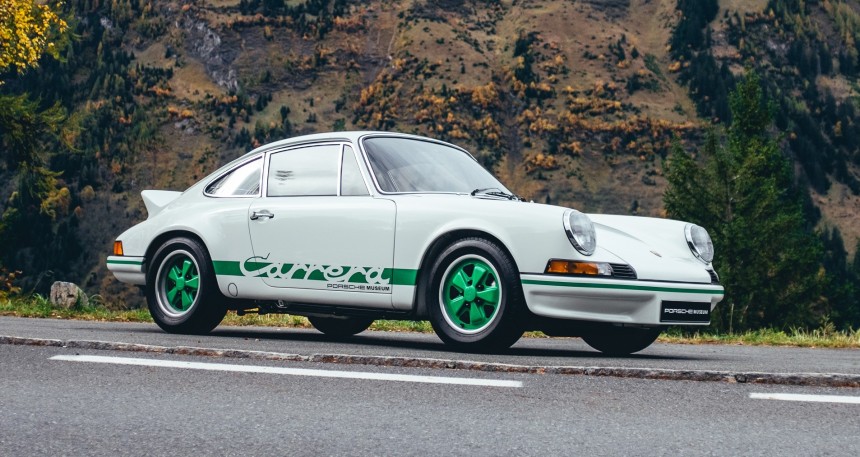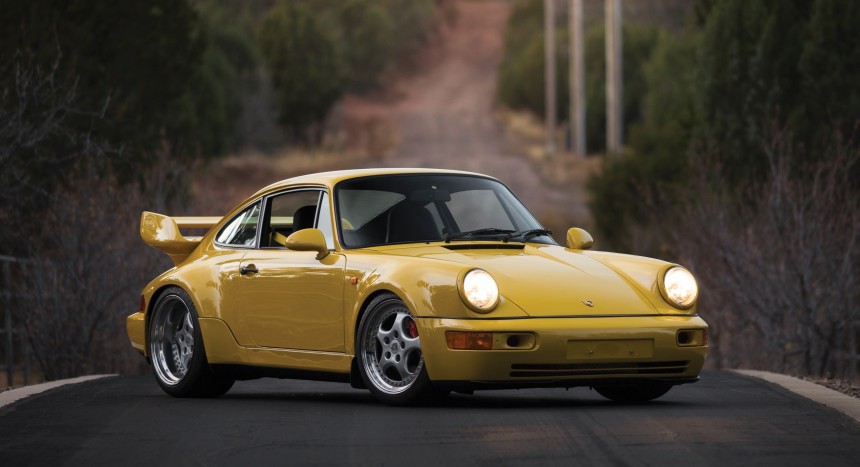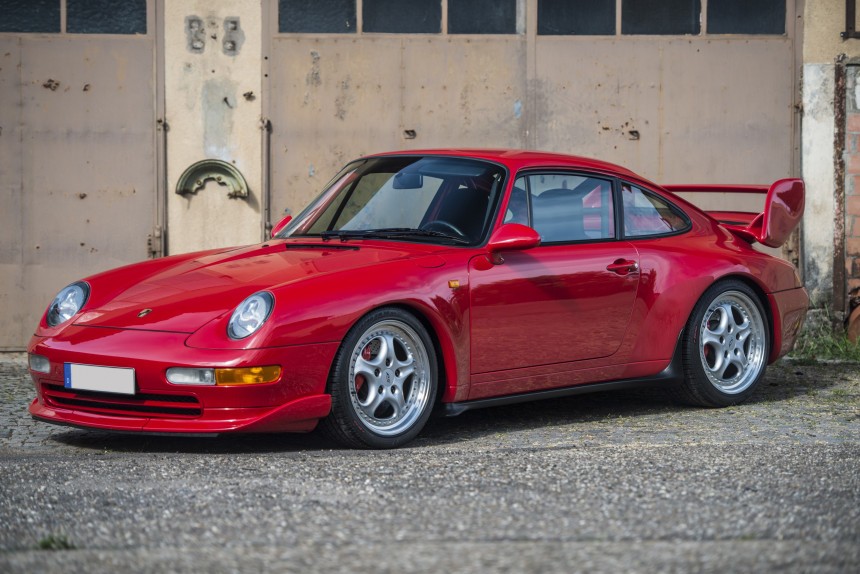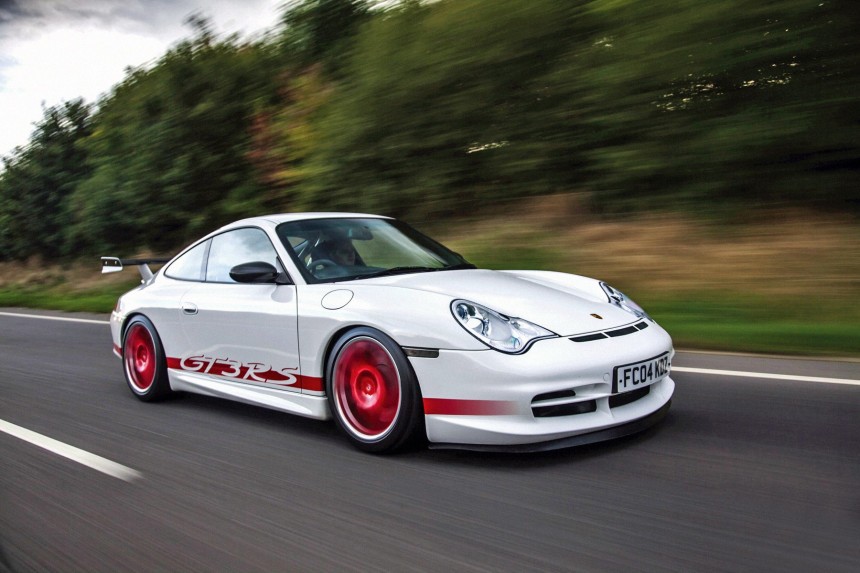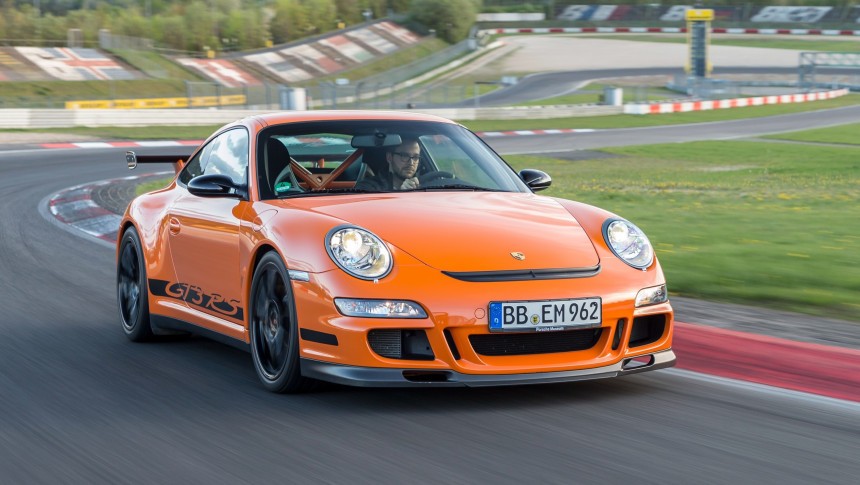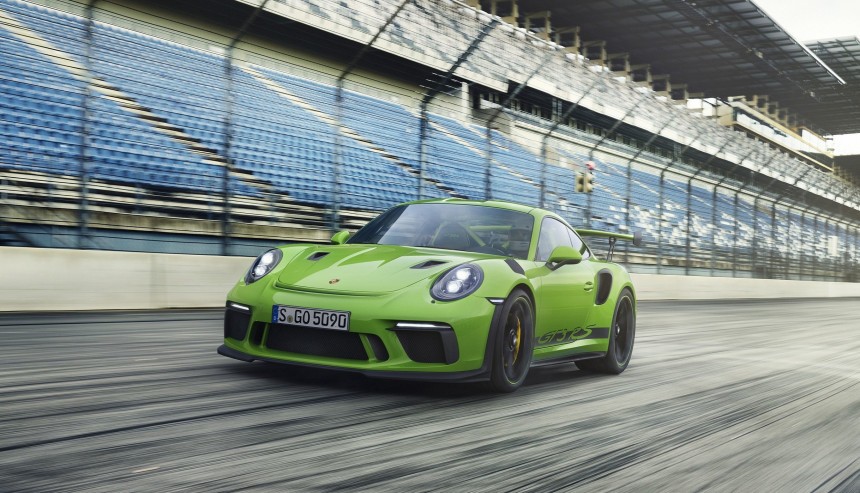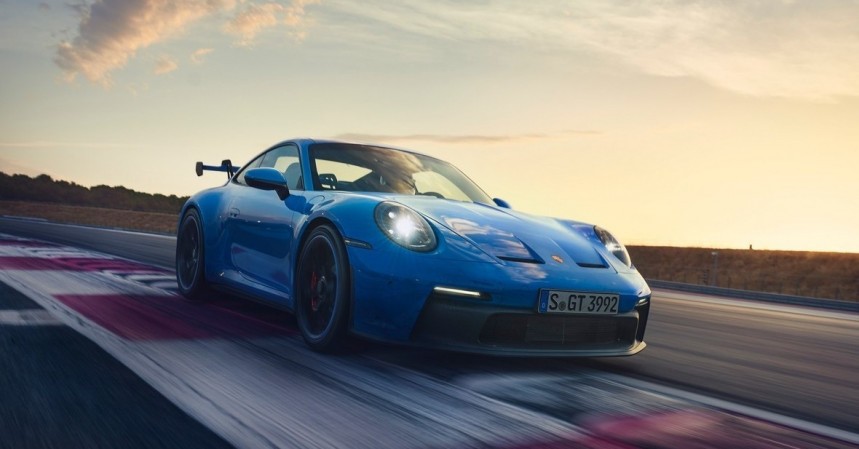Yesterday, Porsche unveiled the 992-generation 911 GT3, the fourth iteration of the already iconic nameplate. Since its original introduction in 1999, the GT3 went through dramatic changes, gaining increasingly more aggressive aero bits and increasingly more powerful engines.
But while the GT3 nameplate is 22 years old as of 2021, the idea is actually much older than that. It all started in the 1970s with the first Carrera RS models. Let's have a closer look at how Porsche's naturally aspirated GT series evolved over the years.
Most enthusiasts agree that the 911 GT3's ancestor is the Carrera 2.7 RS. Developed under the "Rennsport" badge so that the German automaker could enter certain racing series that required a minimum number of production cars, the 2.7 RS was introduced in 1973. It featured a 2.7-liter flat-six good for 207 horsepower, a stiffened suspension, and larger brakes.
Two notable design features set it apart from the 911S: the wider rear fenders, which housed wider wheels, and the now-iconic ducktail rear spoiler. In 1974, Porsche released an upgraded Carrera RS 3.0 model with a larger flat-six that developed 227 horsepower. It was notably more expensive than the 2.7 RS, but it incorporated race-spec technologies from the Carrera RSR and the 917.
Lightweight construction techniques and materials reduced their curb weights to around 1,075 kg and 900 kg (2,370 and 2,000 pounds), respectively. Although FIA Group 4 regulations mandated a production of 500 units, Porsche built in excess of 1,500 examples. The original 911 Carrera RS is now considered to be the greatest classic 911 of all time.
Porsche redesigned the 911 for the first time in 1989, 25 years after its initial introduction. The "RS" badge returned in 1992, built on a similar recipe. It was much lighter, more powerful, and featured race-bred internals. However, unlike the Carrera RS 2.7 and 3.0 RS, the 964-gen RS was not a homologation car.
It was actually based on the previously released 911 Carrera Cup. The Carrera RS 3.6, restricted to the European market, marked the return of the ducktail spoiler in a more aggressive layout. The interior was stripped out of comfort features such as power windows and seats, rear seats, air conditioning, and sound deadening.
The regular front seats were replaced with bucket units, while various components were crafted from aluminum and magnesium. The 3.6-liter flat-six under the hood boasted 260 horsepower and 230 pound-feet (311 Nm) of torque. Later on, Porsche created a limited-edition Carrera 3.8 RS model fitted with a Turbo body and a 3.8-liter engine beefed up to 296 horsepower.
The RS made a second comeback for the 993 generation. Although the 993 911 spawned the first GT car, it was the turbocharged GT2 that first broke cover with this badge. Porsche retained the RS nameplate for the naturally aspirated performance model, which just like its predecessor, arrived with a 3.8-liter flat-six good for 296 horsepower.
The RS now shared the braking system with the 911 Turbo and was fitted with a limited-slip differential as standard. As before, Porsche removed various comfort features and brought in race-bred components, such bucket seats, spartan door panels, and adjustable anti-roll bars backed by Bilstein dampers. The ducktail spoiler remained in place atop the engine lid.
In 1996, one year after the Carrera RS broke cover, Porsche unleashed a more extreme version, called the RS Clubsport. A more track-oriented iteration, it featured a roll cage, a deeper front splitter, and a massive wing out back. Only 1,014 Carrera RS models were produced, and none were sold in the U.S. 911 Carrera RS Clubsport production amounted to only 213 examples.
A major redesign saw the 911 transform into the 996-spec model in 1997. A major departure from the 993, the 996 featured the first all-new chassis since 1964 and a water-cooled engine, putting an end to the air-cooled 911 era. The 996 was also the first 911 to spawn a GT3 version. A spiritual successor to the Carrera RS, the first GT3 remained faithful to the naturally aspirated engine layout, the stripped-out interior, and the race-bred internals.
The first-ever GT3 boasted a 3.6-liter flat-six that had little in common with other 911 engines, as it was based on the unit used in the 962 and 911 GT1 race cars. Designed by the iconic Hans Mezger, it was capable of 355 horsepower. The facelift of 2003 saw output increase to 376 horsepower. The 996.2 GT3 was immediately followed by a more track-focused version: the first ever GT3 RS.
It was lighter thanks to a carbon-fiber hood and rear wing, composite brakes, and a polycarbonate rear window. Output remained unchanged officially, but the RS model was said to deliver 400 horsepower. Impressively enough, the 996 GT3 RS lapped the Nurburgring in 7:43 minutes, four seconds faster than the turbocharged 996 GT2.
The somewhat controversial 996 was replaced by the 997 in 2004 and Porsche needed only two years to come up with a new GT3 model. The first of its kind to be officially rated at more than 400 horsepower, the 997 GT3 broke cover in 2006 with 409 horsepower coming from a 3.6-liter flat-six. It was almost immediately followed by a GT3 RS version that was 20 kg (44 pounds) lighter.
The rear wing stood taller than before and started to look like the GT3 wing we all know today. The mid-cycle upgrade saw the 3.6-liter unit replaced with a 3.8-liter flat-six. Power grew to 429 horsepower, but Porsche didn't stop there. The facelifted GT3 RS received even more oomph, hitting the 444-horsepoewr mark.
But in 2011, just as the 997 911 was going out of production, Porsche unleashed the extreme GT3 RS 4.0. Fitted with a larger, 4.0-liter flat-six, it was good for a whopping 493 horsepower and 339 pound-feet of torque. The GT3 RS 4.0 was a half-second quicker to 60 mph than the regular GT3 and lapped the 'Ring in 7:27 minutes, a new record for the German brand.
And we're down to the most familiar GT3 of all time, the one based on the recently discontinued 991-generation sports car. Viewed as the ultimate GT3 before the 992-gen model arrived, the 991 GT3 was unveiled in 2013 with a 3.8-liter flat-six engine. Aside from the design changes that came with a new-generation 911, the 991 GT3 was pretty much similar to its predecessor.
However, while the engine was a bit more powerful at 469 horsepower, the 991 GT3 was the first of its kind to feature a PDK transmission. Actually, Porsche phased off the manual for the 991.1 model, bringing back only for the facelifted 991.2 version. It was also the first to employ rear-wheel steering. As before, the GT3 was followed by a GT3 RS, rated at 493 horsepower.
This exact same layout was transferred from the 991.1 GT3 RS to the 991.2 GT3, while the upgraded GT3 RS saw output jump to 513 horsepower. The 991-gen GT3 was also the GT3 that spawned most iterations, including a wingless GT3 Touring and a 911 R for purists. The 991.2 GT3 RS was the first GT3 to lap the Nurburgring in under seven minutes, setting a new 6:56.4-minute benchmark.
Finally, the 992-generation GT3 debuted with more of the same, but in a carefully revised package. It features the same 4.0-liter flat-six like its predecessor, but it packs an extra 10 horses for a total output of 503 horsepower. It's still available with a PDK or a six-speed manual.
It's not quicker than its predecessor and tops out at the same 199 mph, but it features a never-before-seen wing design, now with swan neck posts, and a pair of nostrils on the nose, a feature borrowed from the GT3 Cup race car. But while it's not a radical departure from its predecessor, the 992 GT3 is proof that this nameplate has come a long way.
It's more than twice as powerful as its ancestor, the Carrera 2.7 RS and almost twice as quick. When it comes to track performance, Porsche has improved the GT3's Nurburgring lap time by a massive 48 seconds in 24 years. The 992 GT3 was also almost two seconds quicker than the 918 Spyder, a full-blown, state-of-the-art supercar.
Well, I guess there's only one thing left to say at this point: The king is dead, long live the king!
Most enthusiasts agree that the 911 GT3's ancestor is the Carrera 2.7 RS. Developed under the "Rennsport" badge so that the German automaker could enter certain racing series that required a minimum number of production cars, the 2.7 RS was introduced in 1973. It featured a 2.7-liter flat-six good for 207 horsepower, a stiffened suspension, and larger brakes.
Two notable design features set it apart from the 911S: the wider rear fenders, which housed wider wheels, and the now-iconic ducktail rear spoiler. In 1974, Porsche released an upgraded Carrera RS 3.0 model with a larger flat-six that developed 227 horsepower. It was notably more expensive than the 2.7 RS, but it incorporated race-spec technologies from the Carrera RSR and the 917.
Lightweight construction techniques and materials reduced their curb weights to around 1,075 kg and 900 kg (2,370 and 2,000 pounds), respectively. Although FIA Group 4 regulations mandated a production of 500 units, Porsche built in excess of 1,500 examples. The original 911 Carrera RS is now considered to be the greatest classic 911 of all time.
It was actually based on the previously released 911 Carrera Cup. The Carrera RS 3.6, restricted to the European market, marked the return of the ducktail spoiler in a more aggressive layout. The interior was stripped out of comfort features such as power windows and seats, rear seats, air conditioning, and sound deadening.
The regular front seats were replaced with bucket units, while various components were crafted from aluminum and magnesium. The 3.6-liter flat-six under the hood boasted 260 horsepower and 230 pound-feet (311 Nm) of torque. Later on, Porsche created a limited-edition Carrera 3.8 RS model fitted with a Turbo body and a 3.8-liter engine beefed up to 296 horsepower.
The RS now shared the braking system with the 911 Turbo and was fitted with a limited-slip differential as standard. As before, Porsche removed various comfort features and brought in race-bred components, such bucket seats, spartan door panels, and adjustable anti-roll bars backed by Bilstein dampers. The ducktail spoiler remained in place atop the engine lid.
In 1996, one year after the Carrera RS broke cover, Porsche unleashed a more extreme version, called the RS Clubsport. A more track-oriented iteration, it featured a roll cage, a deeper front splitter, and a massive wing out back. Only 1,014 Carrera RS models were produced, and none were sold in the U.S. 911 Carrera RS Clubsport production amounted to only 213 examples.
The first-ever GT3 boasted a 3.6-liter flat-six that had little in common with other 911 engines, as it was based on the unit used in the 962 and 911 GT1 race cars. Designed by the iconic Hans Mezger, it was capable of 355 horsepower. The facelift of 2003 saw output increase to 376 horsepower. The 996.2 GT3 was immediately followed by a more track-focused version: the first ever GT3 RS.
It was lighter thanks to a carbon-fiber hood and rear wing, composite brakes, and a polycarbonate rear window. Output remained unchanged officially, but the RS model was said to deliver 400 horsepower. Impressively enough, the 996 GT3 RS lapped the Nurburgring in 7:43 minutes, four seconds faster than the turbocharged 996 GT2.
The rear wing stood taller than before and started to look like the GT3 wing we all know today. The mid-cycle upgrade saw the 3.6-liter unit replaced with a 3.8-liter flat-six. Power grew to 429 horsepower, but Porsche didn't stop there. The facelifted GT3 RS received even more oomph, hitting the 444-horsepoewr mark.
But in 2011, just as the 997 911 was going out of production, Porsche unleashed the extreme GT3 RS 4.0. Fitted with a larger, 4.0-liter flat-six, it was good for a whopping 493 horsepower and 339 pound-feet of torque. The GT3 RS 4.0 was a half-second quicker to 60 mph than the regular GT3 and lapped the 'Ring in 7:27 minutes, a new record for the German brand.
However, while the engine was a bit more powerful at 469 horsepower, the 991 GT3 was the first of its kind to feature a PDK transmission. Actually, Porsche phased off the manual for the 991.1 model, bringing back only for the facelifted 991.2 version. It was also the first to employ rear-wheel steering. As before, the GT3 was followed by a GT3 RS, rated at 493 horsepower.
This exact same layout was transferred from the 991.1 GT3 RS to the 991.2 GT3, while the upgraded GT3 RS saw output jump to 513 horsepower. The 991-gen GT3 was also the GT3 that spawned most iterations, including a wingless GT3 Touring and a 911 R for purists. The 991.2 GT3 RS was the first GT3 to lap the Nurburgring in under seven minutes, setting a new 6:56.4-minute benchmark.
It's not quicker than its predecessor and tops out at the same 199 mph, but it features a never-before-seen wing design, now with swan neck posts, and a pair of nostrils on the nose, a feature borrowed from the GT3 Cup race car. But while it's not a radical departure from its predecessor, the 992 GT3 is proof that this nameplate has come a long way.
It's more than twice as powerful as its ancestor, the Carrera 2.7 RS and almost twice as quick. When it comes to track performance, Porsche has improved the GT3's Nurburgring lap time by a massive 48 seconds in 24 years. The 992 GT3 was also almost two seconds quicker than the 918 Spyder, a full-blown, state-of-the-art supercar.
